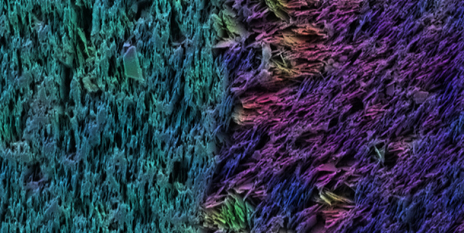A Biomimetic Dental Material As Strong As Tooth Enamel
September 28, 2015
Swiss scientists have developed a technique that enables them to imitate miniature geometries found in biological composites with teeth and seashells. The breakthrough could ultimately lead to the development of synthetic materials with strength comparable to some of the strongest materials in nature.
Brian Buntz
|
A cross section electron microscope image of the artificial tooth shows the geometric orientation of ceramic platelets in its enamel and dentin. Image form Hortense Le Ferrand/ETH Zürich. |
Scientists have only discovered fairly recently why natural structures such as tooth enamel and sea shells are so strong. In the case of teeth, a basket-weave-like microstructure in the enamel helped prevent tiny cracks in the enamel from spreading, making teeth naturally resist cracking despite the fact that enamel is about as brittle as glass. Meanwhile, a pattern of tiny interlocking 'bricks' helps give sea shells their strength.
Now, researchers from ETH Zürich have taken inspiration from the tiny layers of microstructures that gives such natural materials their strength while also allow replicating the complexity of the structures found within them.
Led by ETH professor André Studart, the researchers were able to produce a complex natural material composed of multiple layers of micro-platelets with an identical configuration in each layer.
To accomplish that, the researchers used a technique known they call magnetically-assisted slip casting. The technique required the researcher to first make a plaster cast mold into which was poured a liquid with magnetized ceramic platelets. Because plaster is porous, it gradually absorbs the liquid in the suspension, enabling the platelets to settle. They can fine tune the orientation of the particles through the application of a magnetic field, which enables the ceramic platelets to be aligned with the magnetic field when the mixture is still in liquid form.
Sintering the final materials densifies and hardens them further.
The technique, which the researchers say is roughly similar to 3-D printing but cheaper and faster, could also be used to make dental prostheses.
To demonstrate the promise of MASC for dentistry, the researchers created an artificial tooth with microstructures that mimic those of a natural tooth. "The profile of hardness and toughness obtained from the artificial tooth corresponds exactly with that of a natural tooth," Sudart said in a statement.
Learn more about cutting-edge medical devices at MD&M Philadelphia, October 7-8, 2015. |
Like what you're reading? Subscribe to our daily e-newsletter.
About the Author(s)
You May Also Like



